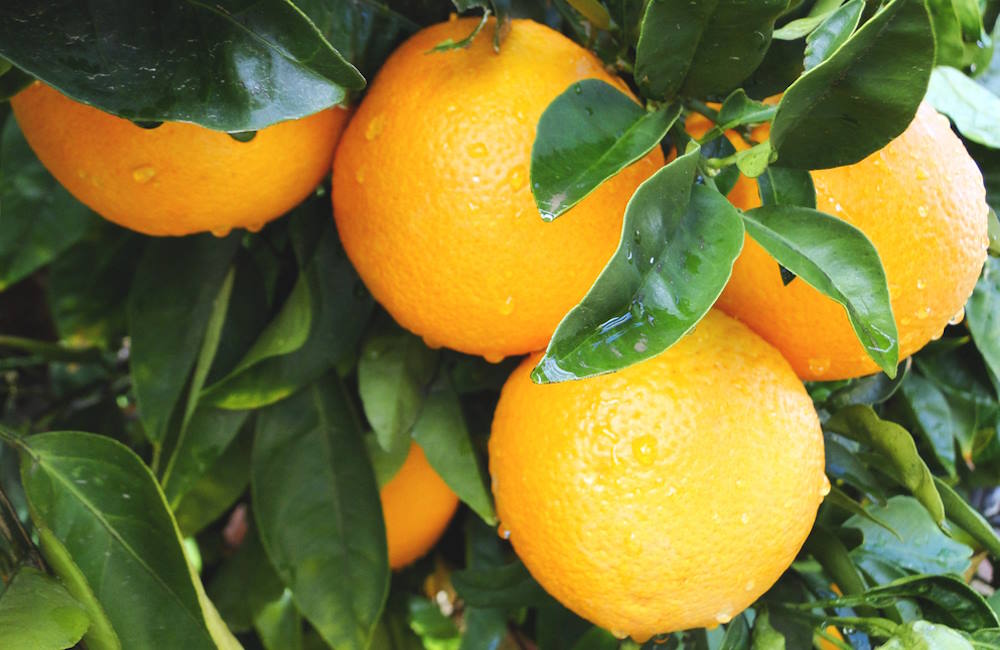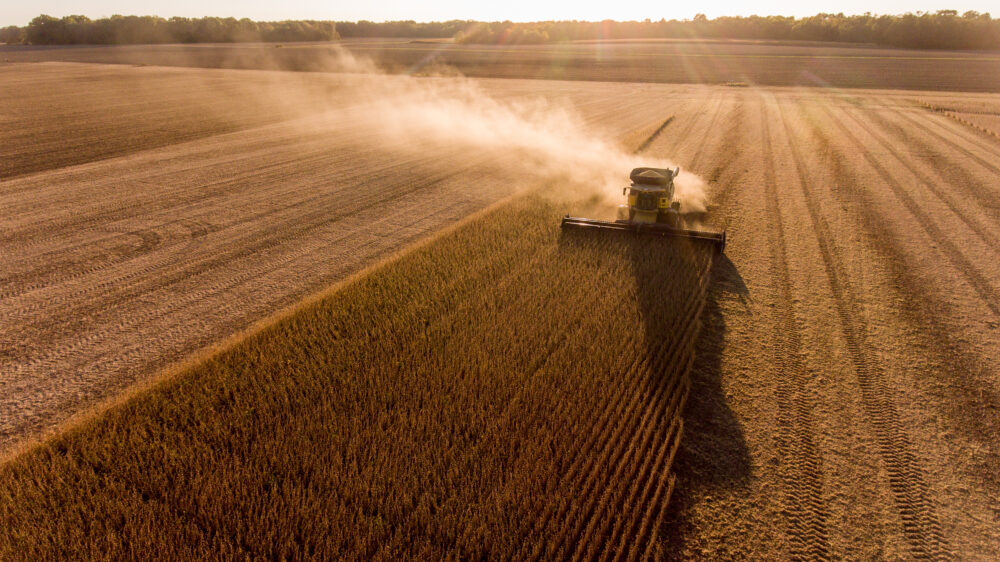Cascading Impact of Tropical Storms on Florida Orange Juice Production
Share This Story, Choose Your Platform!
Warm surface temperatures in the Atlantic Ocean are likely to result in a more active 2023 hurricane season. We have seen evidence of this with tropical storms Bret and Cindy forming in the central Atlantic in mid-June, which is highly unusual. Typically, when we see tropical storms this early in the year, they form in the comparatively warmer waters of the Caribbean or Gulf of Mexico. This is actually the first time on record that two named storms have formed east of the Antilles in June. While neither storm is on track to make landfall in Florida, they could still be a red flag for the state’s orange growers and orange juice production.
Nearly all orange production in the United States occurs in either Florida, which is focused primarily on the juice industry, or California, which mainly supplies produce for grocery stores. Commodity futures traders are concerned with one specific aspect of the orange market, the famed Frozen Concentrated Orange Juice (FCOJ) contract, making Florida the more relevant state for our purposes.
Frequent volatility caused by the threat of tropical storms in the summer, frost damage in the winter, and disease or insect infestation, have historically made FCOJ a favorite among risk tolerant speculators. While that volatility persists to this day, many of the underlying fundamentals have changed greatly.

The Impact of Florida Hurricanes on Orange Juice Production
When potential hurricanes begin to approach the southeastern U.S., the immediate concern for most people is the devastation and threat to human life caused by direct impact near the Atlantic and Gulf coasts. Genuine concern for our fellow man is compounded by attention-grabbing headlines about wind-speed which are accompanied by satellite photos showing the size of the storm and projections for where it might make landfall. In the aftermath, flooded cities and ravaged beachfront property are shown on the front page.
When viewed through the lens of a commodity trader, we temporarily suspend that concern in order to make logical decisions about how hurricanes will impact commodity markets. This includes not only the immediate direct impact of wind and rain, but also the downstream effects that short-term traders often overlook.
Florida is the tip of the spear when it comes to tropical storms. The vulnerability of Florida’s orange groves cannot be overstated, as a powerful storm reaching the central peninsula can easily result in destruction of half the state’s crop. In severe instances, powerful winds may uproot or knock branches off a large number of trees, which take multiple years to regrow. This vulnerability is a primary reason why so much of global orange production has shifted from Florida to places like Brazil and Mexico in recent decades.
Supply Fundamentals and Trends for Orange Juice
Florida orange production has been on a twenty-year steep downward trajectory, but it truly fell off a cliff this year as Citrus Greening disease decimated an already small crop. For the first time in memory, California will be the top orange producing state in 2023.
Florida is projected to yield 16 million boxes (about 650,000 metric tons) of oranges this year, down 60% from last year and down more than 90% from the totals in the early 2000s when Florida routinely produced over 200 million boxes (about 8 million metric tons). The Florida orange crop in 2023 will be the smallest since before frozen concentrated orange juice was developed as a product in 1945.
The global production forecast is not nearly as dire, with analysts expecting 47.5 million metric tons – a decline of 5% from last year. This still creates a constrained supply situation as 2022 was a relatively weak harvest, as well, resulting in smaller stockpiles coming into the season.
In May 2023, when FCOJ reached an all-time high of $2.95 per pound, there had been additional concerns which have since subsided. It was feared that a volcanic eruption in Mexico would adversely affect production and interfere with harvesting activities, but that now seems to have had a minor impact. Concern that heavy rain in Brazil would damage the crop also passed without coming to fruition.
Demand Factors and Consumer Preference
Orange juice corporate marketing teams used to emphasize that their product was made with 100% Florida oranges, and that it was “not from concentrate.” A close look at the refrigerated shelf in the supermarket today will show that both of those claims have been removed due to the reduction in Florida’s prominence in this industry. Even brands like Florida’s Natural now use a blend of juices from around the world, with an unspecified percentage coming from Florida.
Orange juice is no longer a staple at the family breakfast table for a variety of reasons, not least because few people actually sit down at a family breakfast table anymore. We are an on-the-go society that tends to prefer caffeinated beverages in the morning. Health-conscious motivations, primarily the desire to reduce sugar consumption, have also led to weaker demand in recent years.
People still enjoy orange juice, but there is more of a take it or leave it attitude from consumers. With families facing economic uncertainty and inflated grocery bills across the board, orange juice will struggle to maintain a place on their shopping lists. Products from Brazil, which produces a third of the world’s oranges, are especially hard hit by inflation as the Brazilian real strengthens against the U.S. dollar.
This translates to an average retail price of more than $6 per gallon for reconstituted (from concentrate) orange juice. The fresh-squeezed variety, if you can find it, is over $10 per gallon. We are in uncharted territory with regard to high prices, production shortfalls, and consumer indifference, making it difficult to predict the exact price point at which demand will totally collapse.
Conclusion and Outlook
The market has a knee-jerk reaction to bid up FCOJ when hurricanes approach the Florida peninsula, but that is not our approach to trading. Speculating on the impact of a single storm is more of a bet than an investment. However, price action caused by short-term weather events may create attractive entry points for longer term fundamental-based positions.
With the price of orange juice still near its record high, and demand waning, we would not initiate a long position at these levels. A trader with a long-term bearish outlook on FCOJ futures could look to take advantage of the weather premium to initiate a short position, but we wouldn’t suggest doing so this early in the season.
We are currently taking a wait and see approach, as lower prices are expected in 6 months but it’s far too early to call a top in this market today. Should hurricane threats drive prices above $3 per pound in late summer or early autumn, a bearish position will be worth serious consideration.
While we view 2023 as an outlier due to Citrus Greening disease, and expect Florida orange production to rebound significantly in 2024, the long-term downward trend will likely continue until the state’s orange industry is little more than a novelty.
Population growth in Florida over the past several years has driven up housing demand and real estate values, which will leave multigenerational orange growers with a decision to make. They can continue producing a crop with significant risks and vanishing demand, or they can sell their land to a real estate developer. That may be an oversimplification, but the writing is on the wall that acreage will decline in coming years. An increase in the prevalence of severe hurricanes would accelerate that trend.
Share This Story, Choose Your Platform!
Cascading Impact of Tropical Storms on Florida Orange Juice Production
Share This Story, Choose Your Platform
Warm surface temperatures in the Atlantic Ocean are likely to result in a more active 2023 hurricane season. We have seen evidence of this with tropical storms Bret and Cindy forming in the central Atlantic in mid-June, which is highly unusual. Typically, when we see tropical storms this early in the year, they form in the comparatively warmer waters of the Caribbean or Gulf of Mexico. This is actually the first time on record that two named storms have formed east of the Antilles in June. While neither storm is on track to make landfall in Florida, they could still be a red flag for the state’s orange growers and orange juice production.
Nearly all orange production in the United States occurs in either Florida, which is focused primarily on the juice industry, or California, which mainly supplies produce for grocery stores. Commodity futures traders are concerned with one specific aspect of the orange market, the famed Frozen Concentrated Orange Juice (FCOJ) contract, making Florida the more relevant state for our purposes.
Frequent volatility caused by the threat of tropical storms in the summer, frost damage in the winter, and disease or insect infestation, have historically made FCOJ a favorite among risk tolerant speculators. While that volatility persists to this day, many of the underlying fundamentals have changed greatly.

The Impact of Florida Hurricanes on Orange Juice Production
When potential hurricanes begin to approach the southeastern U.S., the immediate concern for most people is the devastation and threat to human life caused by direct impact near the Atlantic and Gulf coasts. Genuine concern for our fellow man is compounded by attention-grabbing headlines about wind-speed which are accompanied by satellite photos showing the size of the storm and projections for where it might make landfall. In the aftermath, flooded cities and ravaged beachfront property are shown on the front page.
When viewed through the lens of a commodity trader, we temporarily suspend that concern in order to make logical decisions about how hurricanes will impact commodity markets. This includes not only the immediate direct impact of wind and rain, but also the downstream effects that short-term traders often overlook.
Florida is the tip of the spear when it comes to tropical storms. The vulnerability of Florida’s orange groves cannot be overstated, as a powerful storm reaching the central peninsula can easily result in destruction of half the state’s crop. In severe instances, powerful winds may uproot or knock branches off a large number of trees, which take multiple years to regrow. This vulnerability is a primary reason why so much of global orange production has shifted from Florida to places like Brazil and Mexico in recent decades.
Supply Fundamentals and Trends for Orange Juice
Florida orange production has been on a twenty-year steep downward trajectory, but it truly fell off a cliff this year as Citrus Greening disease decimated an already small crop. For the first time in memory, California will be the top orange producing state in 2023.
Florida is projected to yield 16 million boxes (about 650,000 metric tons) of oranges this year, down 60% from last year and down more than 90% from the totals in the early 2000s when Florida routinely produced over 200 million boxes (about 8 million metric tons). The Florida orange crop in 2023 will be the smallest since before frozen concentrated orange juice was developed as a product in 1945.
The global production forecast is not nearly as dire, with analysts expecting 47.5 million metric tons – a decline of 5% from last year. This still creates a constrained supply situation as 2022 was a relatively weak harvest, as well, resulting in smaller stockpiles coming into the season.
In May 2023, when FCOJ reached an all-time high of $2.95 per pound, there had been additional concerns which have since subsided. It was feared that a volcanic eruption in Mexico would adversely affect production and interfere with harvesting activities, but that now seems to have had a minor impact. Concern that heavy rain in Brazil would damage the crop also passed without coming to fruition.
Demand Factors and Consumer Preference
Orange juice corporate marketing teams used to emphasize that their product was made with 100% Florida oranges, and that it was “not from concentrate.” A close look at the refrigerated shelf in the supermarket today will show that both of those claims have been removed due to the reduction in Florida’s prominence in this industry. Even brands like Florida’s Natural now use a blend of juices from around the world, with an unspecified percentage coming from Florida.
Orange juice is no longer a staple at the family breakfast table for a variety of reasons, not least because few people actually sit down at a family breakfast table anymore. We are an on-the-go society that tends to prefer caffeinated beverages in the morning. Health-conscious motivations, primarily the desire to reduce sugar consumption, have also led to weaker demand in recent years.
People still enjoy orange juice, but there is more of a take it or leave it attitude from consumers. With families facing economic uncertainty and inflated grocery bills across the board, orange juice will struggle to maintain a place on their shopping lists. Products from Brazil, which produces a third of the world’s oranges, are especially hard hit by inflation as the Brazilian real strengthens against the U.S. dollar.
This translates to an average retail price of more than $6 per gallon for reconstituted (from concentrate) orange juice. The fresh-squeezed variety, if you can find it, is over $10 per gallon. We are in uncharted territory with regard to high prices, production shortfalls, and consumer indifference, making it difficult to predict the exact price point at which demand will totally collapse.
Conclusion and Outlook
The market has a knee-jerk reaction to bid up FCOJ when hurricanes approach the Florida peninsula, but that is not our approach to trading. Speculating on the impact of a single storm is more of a bet than an investment. However, price action caused by short-term weather events may create attractive entry points for longer term fundamental-based positions.
With the price of orange juice still near its record high, and demand waning, we would not initiate a long position at these levels. A trader with a long-term bearish outlook on FCOJ futures could look to take advantage of the weather premium to initiate a short position, but we wouldn’t suggest doing so this early in the season.
We are currently taking a wait and see approach, as lower prices are expected in 6 months but it’s far too early to call a top in this market today. Should hurricane threats drive prices above $3 per pound in late summer or early autumn, a bearish position will be worth serious consideration.
While we view 2023 as an outlier due to Citrus Greening disease, and expect Florida orange production to rebound significantly in 2024, the long-term downward trend will likely continue until the state’s orange industry is little more than a novelty.
Population growth in Florida over the past several years has driven up housing demand and real estate values, which will leave multigenerational orange growers with a decision to make. They can continue producing a crop with significant risks and vanishing demand, or they can sell their land to a real estate developer. That may be an oversimplification, but the writing is on the wall that acreage will decline in coming years. An increase in the prevalence of severe hurricanes would accelerate that trend.






